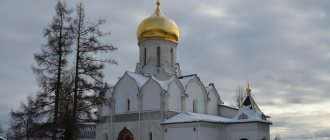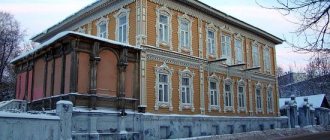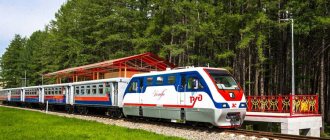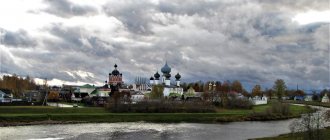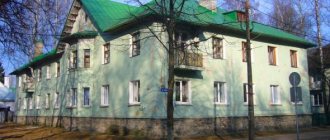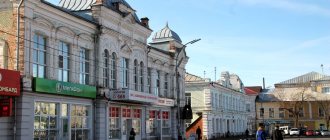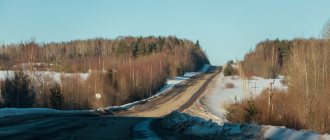Zvenigorod is one of the ancient cities of Russia.
It is located in the Moscow region, on the banks of the Moscow River. It is easy to get from Moscow to Zvenigorod, the drive is only 30 km. The city got its name from the word “Ring” or “Ringing”, from the chimes of bells that were heard here on holidays and weekdays and were heard far beyond its borders. It is a popular cultural and resort city in Central Russia. There are many ancient monuments because the city has a rich history. If you would like to take a look at the city, you are welcome. You will see the beautiful sights of Zvenigorod and get acquainted with the history of the city. Today we will advise you what to see in Zvenigorod. 10 best hotels in Zvenigorod (from RUB 2,028) on Booking =>>
Savvino-Storozhevsky Monastery
Monument to Savva Storozhevsky
Website: www.savvastor.ru Address: Ratekhinskoye sh., 8.
The Savvino-Storozhevsky Monastery was founded in 1398 on the banks of the Moskva River at the request of Prince Yuri of Zvenigorod, the second son of Prince Dmitry Donskoy. To create a monastery, he invited a disciple of Sergius of Radonezh, the Monk Savva.
Cathedral of the Nativity
The basis of the monastery was the wooden Nativity Cathedral built on Mount Storozh. In 1404-1405, a white stone temple was erected in its place, which belongs to early Moscow architecture. The Monk Savva was buried in the Nativity Cathedral.
The bell tower is the tallest building on the territory of the monastery.
Over its long life, the monastery took part in many historical events and saw many great princes, kings and emperors within its walls. During the time of Tsar Alexei Mikhailovich, the royal palace and royal chambers were built here. The Savvino-Storozhevsky Monastery became a country residence for the royal family in the 17th century.
Royal Palace
During the Patriotic War of 1812, the monastery was occupied by the French and suffered. It was closed in 1918, here on May 15 of the same year the Zvenigorod rebellion took place and three people representing the Bolshevik government were killed. In 1919, the shrine containing the relics of Savva Storozhevsky was publicly opened as part of anti-religious propaganda.
The monastery reopened in 1995. A new shrine was created to store the relics, which is now located in the monastery.
The importance of the city in the modern world
According to the first chronicle mentions, in the place where Zvenigorod is now located, Yuri Dolgoruky, during his reign, founded a fortified settlement protecting the Moscow Principality from enemies coming from the west.
Almost two centuries later, the settlement grew into a small city, and Ivan Kalita gave it into the possession of his son, who continued to improve the defensive structures. During the reign of Dmitry Donskoy, a fortress was erected, and his son, Yuri Dmitrievich, made additional fortifications. Zvenigorod-Moskovsky was also of great importance in the defense of the Chernigov principality.
The fortress, fortified with earthen ramparts, ditches and defensive wall fortifications, has been called Gorodok by residents from ancient times to the present day.
From the very foundation of the settlement, temples, cathedrals and monasteries were built on its territory - Zvenigorod was not only the center of the squad and tax collectors, but also was the place of establishment of Orthodox associates. So in the 14th century the Assumption Cathedral and the Savvino-Storozhevsky Monastery were built in Gorodok.
When exactly the fortress was given the name Zvenigorod is not clearly stated anywhere, but it is known that some settlers began to call the city that by analogy with their homeland - Zvenigorod of Kyiv, which was destroyed by raids of nomadic tribes.
Also, thanks to the abundance of churches, the ringing of bells was heard : Zvenigorod - the ringing city.
Modern Zvenigorod
Today Zvenigorod belongs to the Moscow region, to the Odintsovo urban district, its area is 48.1 square meters. km. Coordinates on the world map: 55 degrees 44 minutes north latitude; 36 degrees 52 minutes east longitude.
Being on the territory of the Odintsovo urban district, Zvenigorod borders on such villages and villages as:
- Ershovskoye (in the west and north);
- Uspenskoe (in the east);
- Zakharovskoe (in the south);
- Nikolskoye (in the southwest).
Zvenigorod Museum
Royal Chambers
Website : zvenmuseum.ru Address: on the territory of the Savvino-Storozhevsky Monastery. Opening hours: from 10.00 to 18.00 (ticket office until 17.00) daily, except Monday. In summer: Tuesday - Friday, Sunday from 10.00 to 18.00 (ticket office until 17.30), Saturday from 10.00 to 19.00 (ticket office until 18.30). Cost of a full ticket (2 expositions + 2 exhibitions): 280 rubles, pensioners - 200 rubles, schoolchildren and students - 160 rubles, preschoolers - free.
The museum in Zvenigorod was created in 1920, its history was not easy. At first the museum was located in the Vvedenskoye estate; in 1923 it moved to the closed Savvino-Storozhevsky Monastery. The main museum funds were valuables from the monastery sacristy and items from surrounding estates.
In 1927, a commune for street children was opened in the monastery and the museum was closed, but was reopened in 1928. In 1939, the museum was closed again due to the location of a military unit in the monastery. The main exhibits were transferred to the museum of the city of Istra, the rest were taken to the Assumption Cathedral in Zvenigorod - it was there that the museum was reopened in 1944.
In 1946, the Assumption Cathedral was handed over to believers and the museum was again moved to the territory of the former monastery, where the sanatorium was located. In 1987, the museum became the owner of the entire territory of the monastery, but already in 1995 the Russian Orthodox Church resumed its work here. Currently, museum workers are located in a single building - in the Royal Chambers. All other buildings were transferred to the Russian Orthodox Church.
The full name of the museum is Zvenigorod Historical, Architectural and Art Museum. In 1972, the works of the People's Artist of the RSFSR, artist B. N. Yakovlev, were transferred to the museum, which served as the beginning of a collection of paintings.
Main attractions of Zvenigorod
Zvenigorod, whose attractions can be listed for a long time, is called “Russian Switzerland” for the purity of nature and the unique atmosphere that reigns in this small ancient town.
Literally every corner of Zvenigorod either carries an amazing story of origin, or was a witness to grandiose historical events. A little about the most outstanding historical, cultural and religious attractions:
Religious buildings
Services were held in numerous temples and churches in Zvenigorod even before the invasion of Russia by the Golden Horde . Holy associates and military warriors were raised in monasteries. Only a part is presented here, but it also allows you to feel all the greatness of Rus'.
Savvino-Storozhevsky Monastery
The monastery was founded at the turn of the 13th-14th centuries. and it survived two eras of construction. The Monk Savva Storozhevsky, with the help of his son Dmitry Donskoy, initially built a small church named in honor of the Nativity of the Blessed Virgin Mary. Monastic cells were also equipped at the temple, and the territory belonging to the monastery itself was small.
In just a few years, the number of monks increased significantly; the need arose to build new cells, as well as to strengthen and protect the monks from dashing people. And after 7 years, the monks erected the Cathedral of the Nativity of the Blessed Virgin Mary, made of white stone.
A year later, the Venerable Savva of Storozhevsky, the Zvenigorod Wonderworker and disciple of Sergius of Radonezh, was buried at the entrance to the Cathedral.
During the times of numerous wars and raids, as well as during the campaigns through Zvenigorod of False Dmitriev I and II, the buildings of the monastery were brutally destroyed and plundered, and for some time the monks managed to rebuild only the most necessary buildings. Thorough restoration began only during the reign of the first of the Romanov family - Mikhail Fedorovich.
Today the monastery is inhabited by 30 monks and novices, repair and restoration work is continuously carried out. Services are held regularly, not only on the territory of the monastery, but also in the churches assigned to it.
Adults can take two-year courses, justified by the decree of Catherine the Great. The monastery also has a shelter for boys left without the care of their relatives.
Address of the Savvino-Storozhevsky Monastery: Zvenigorod, Ratekhinskoye Highway, 8. Open daily from 6:00 until the end of the evening service.
Cathedral of the Assumption of the Virgin Mary on Gorodok
The cathedral and man-made 8-meter embankments of the protective structure are all that remain on the site of the ancient Town, which laid the foundation for the construction of the city of Zvenigorod. The Cathedral was erected on the instructions of Yuri of Zvenigorod, who returned from a military campaign - before the campaign, the Monk Savva predicted victory for him.
The Cathedral of the Assumption of the Virgin Mary was erected in 1399 ; the white stone structure reflects the style of early Suzdal, Moscow and Vladimir architecture. Moreover, after careful study and measurement, it turned out that the massive parts of the Cathedral are slightly narrowed at the top, which allows the building to appear larger than in reality.
At the beginning of the 15th century, Andrei Rublev was involved in the design of the Cathedral, but unfortunately, few elements of the frescoes have been preserved at present.
Address of the Cathedral of the Assumption of the Virgin Mary: Zvenigorod, st. Town, 1.
Church of the Ascension of the Lord
Erected in the spirit of classicism at the end of the 18th century on the site of an old wooden one, this church has experienced many tragic moments. During the war with Napoleon, it suffered raids, destruction and looting by the French army. Upon completion, the temple was restored and a refectory was added, with donations from one of the merchants.
During Soviet times, the temple was first closed and then completely destroyed. And only at the beginning of this century the temple was rebuilt, but according to a new design, although it retained the general composition.
Address of the Ascension Temple: Zvenigorod, st. Moskovskaya, 2a.
Church of the Epiphany on Gorodok
In order to relieve the Cathedral of the Assumption of the Mother of God from divine services, and to preserve its priceless paintings and frescoes, a wooden church was built nearby. It was erected at the end of the century before last, but less than 40 years later the Bolsheviks burned the church. The restoration of the church took place with the blessing of Alexy II in the early 2000s.
Address of the Church of the Epiphany: Zvenigorod, st. Gorodok, 2a.
Alexander Nevsky Church
In 1898, construction began on the Alexander Nevsky Church; its construction was carried out as a tribute to the memory of Emperor Alexander III the Peacemaker. During Soviet times, the cemetery at the church was destroyed, and various institutions were alternately located in the building itself. After the collapse of the USSR, the temple was again transferred to the ownership of the church. Regular services are now held here.
Address of the Alexander Nevsky Church: Zvenigorod, st. Moskovskaya, 35.
Museums
There are several museums in Zvenigorod, with unique exhibitions and excursions.
Museum of Lyubov Orlova
Zvenigorod, whose attractions are numerous, has a unique place - the Cultural Center named after. Lyubov Orlova . This museum displays more than 150 exhibits - objects, portraits and photographs - that are inextricably linked with the fate and work of the great actress.
Authentic costumes used during filming, fascinating excursions, and film screenings envelop museum visitors in the spirit of the early 20th century. To the sounds of Dunaevsky's compositions, you can get closer to solving the mystery of the mystery woman Lyubov Orlova.
address : Zvenigorod, st. Moskovskaya, 11.
Opening hours : the museum is open from Tuesday to Saturday, visiting hours from 11:00 to 18:00;
Ticket price : For adults 100 rubles, for children and pensioners 50 rubles, for combatants, disabled children, disabled people of groups 1 and 2, as well as museum employees, admission is free. When viewing the composition with a guide, the cost of tickets increases: for the first group of visitors - by 50 rubles, for the second - by 30 rubles.
Museum of Russian Dessert
An original and distinctive museum dedicated to the restoration of original Russian cuisine. On fascinating excursions you can get acquainted with the history of preparing traditional Russian cuisine, and independently prepare the delicacies with which both boyars and merchants and peasants drank tea.
You can not only watch the tradition of tea drinking, which has long been observed in Rus', but also take part in it, with sweets prepared with your own hands. The interior of the museum is completely designed and executed in a style corresponding to the time of the founding of the city. The museum's organizers are constantly researching material to restore Russian recipes.
Museum address : Zvenigorod, st. Frunze, 23/2.
The cost of excursions for adults is from 400 rubles, for children from 300 rubles.
Opening hours : Every day from 10:00 to 20:00
Museum "Back to the USSR"
Not long ago, a museum opened in Zvenigorod, which conveys to visitors the mood and spirit of the era of the construction of communism. The exhibits are presented in various temporary exhibitions and museum guests will be able to feel and remember, or just get acquainted with, the life and culture of the Soviet Union.
The museum organizes two types of excursions - for young and adult visitors. There is a dining room, the interior and dishes of which correspond to the composition of the museum. You can also visit the souvenir shop, where you can buy small items reminiscent of the USSR.
Museum address : Zvenigorod, st. Moskovskaya, 7/9.
The cost of visiting an adult is 350 rubles, a child is 250 rubles, children under 5 years old are free.
Opening hours from 10:00 to 20:00 daily.
Zvenigorod Historical, Architectural and Art Museum
The museum is located on the territory of the Savvino-Storozhesky Monastery, and begins its exhibition with the Tsarina’s Chambers - this is a small museum-estate built in the 17th century for the wife of Tsar Alexei Mikhailovich. Today, the exhibition, arranged in three small rooms, recreates the life of the royal person and is called “The Chambers of the Boyar”.
The further excursion takes place around the monastery, where unique architectural monuments are collected, carefully preserved by monks and museum workers to this day. The guides will tell you a detailed and fascinating history of the emergence and development of Zvenigorod, as well as its role in the history of Rus'.
Museum address : Zvenigorod, st. Town, 5.
Ticket prices vary depending on the choice of excursions and exhibits.
Opening hours : from 10:00 to 18:00 from Tuesday to Sunday.
Natural attractions
Zvenigorod is not limited to man-made attractions; natural objects are no less valuable:
- Boulder near Kolyubakino. According to scientists, the huge stone is the same age as the Ice Age. The boulder weighs 55,000 kg; several years ago it was moved from a sand quarry to the Church of the Icon of the Mother of God. According to legend, the Monk Savva prayed near this stone. Today this boulder is considered a place that gives strength and fulfills wishes. Every day tourists and pilgrims come to him to make their most secret wishes, and many return to thank him. Where to find the stone: Zvenigorod, village. Kolyubakino.
- Dunino settlement. The historical and archaeological complex of the Dunin settlement is located 6 km from Zvenigorod and is the best preserved settlement of nomads who lived in the Iron Age. The open-air museum was discovered in the 40s of the last century and since then archaeological excavations have been regularly carried out, bringing a large amount of useful material that allows us to restore certain historical moments of the life of ancient settlers. Address: Zvenigorod, microdistrict sanatorium "Porechye".
- Mozzhinsky ravine. The reserve complex includes about 40 hectares of untouched forest. The nature reserve is protected by the state and includes about 200 species of flora and more than 50 representatives of fauna. Some of the birds and animals found in the Mozzhinsky ravine are listed in the Red Book.
Monuments
When traveling around Zvenigorod, you cannot miss visiting the monuments erected to great people with whom the history of the city is connected:
- Monument to Yuri Zvenigorodsky and St. Savva Storozhevsky. Installed in a city park near the entrance to the city, the monument became a meeting place for lovers, as well as a destination for various meetings. Immediately after its opening, the square itself became a favorite place for walks among city residents. The monument was erected to people who can rightfully be considered the founders of the city - they made a significant contribution to the development and the historical sights built with their participation are admired by all of Russia to this day.
- Monument to Chekhov with a dog. In the central square at the entrance to the hotel there is a bench where you can sit, relax and take a photo with the famous writer and doctor, Anton Pavlovich Chekhov. The writer sits in a relaxed resting position, and his dog sits next to him. Zvenigorod residents consider Anton Pavlovich their fellow countryman, since after graduating from Moscow University it was in this city that Chekhov practiced medicine for several years.
Monk Sava's monastery
The story goes that Savva Storozhevsky (Zvenigorodsky) made a refuge in a cave, where he spent the remaining days of his life, devoting them to prayers. Later, in the 19th century, a monastery was erected on this site.
During the Soviet era, the monastery was seriously damaged; buildings on its territory were destroyed or looted. In the 2000s, the buildings began to be restored: two churches were rebuilt and a monastery bathhouse was erected. The most beautiful building of the monastery is the Church of Sava, decorated with white stone decoration in the pseudo-Russian style.
Zvenigorod town
Assumption Cathedral on Gorodok
Gorodok in Zvenigorod is the remains of the Kremlin and the center of the ancient city. Now there is almost nothing left on the site of the fortress, once reliably protected by towers and earthen embankments. The most significant building is the Assumption Cathedral on Gorodok - the oldest temple in the city (late 14th - early 15th centuries), it is very reminiscent of the famous Church of the Intercession on the Nerl.
Most tourists, when visiting the sights of Zvenigorod, begin with the Assumption Church. The 15th century paintings of Andrei Rublev and Danila Cherny have been preserved here.
What to bring as a souvenir
In Zvenigorod there is an unusual shopping complex, stylized as a Russian street from the mid-century. There are many shops on it where you can choose unusual hand-made gifts and souvenirs for any, even the most demanding taste.
Zvenigorod is a city filled with history; its attractions will leave an indelible mark on the soul after visiting.
I want to come back here and fill my heart with beauty and tranquility. The city with singing and ringing bells always welcomes guests.
Author of the article: Shishlina Anna
Article design: Svetlana Ovsyanikova
Ascension Church
Address: Moskovskaya st., 2A.
In 1791, a stone Ascension Church was erected on this site on the site of an ancient wooden one. Before the Soviet period, this was the main temple in the city. In 1922, the church was closed for services and was used as a grain warehouse, and then as a garage. Before the start of the Great Patriotic War it was dismantled.
For many years, the site of the temple was a wasteland; the Church of the Ascension was rebuilt in 2007. The new building was built in the neo-Byzantine style and does not in any way resemble the historical building.
Red Mountain Street
After visiting Chekhov's places, we go to the center of Zvenigorod. On the way up, Red Mountain Street is filled with private houses. I am glad that some modern houses fit well into the ancient Russian buildings. For example, the houses opposite Chekhov's house.
There are some(!) houses that are well looked after and maintained in appearance. Nice houses, but the fence ruins everything. I don’t even know which of these fences is worse.
Literally five meters later, a low-rise residential complex rises in front of us.
On the other side of the road is just some kind of golden palace of an Indian Raja.
I wonder if it’s normal for residents of a golden new building to see this from their window every day?
Or that?
Or this? By the way, in this terrible house from 1922 to 1941. the Zvenigorod planetary school was located , and then the flying club , whose cadets became pilots during the Great Patriotic War. Zvenigorod, aren't you ashamed?
Chekhov in Zvenigorod
In 1884, A.P. Chekhov worked for some time as the head of the Zvenigorod City Hospital. Working here gave him many creative ideas for his works. In memory of the great writer, memorial plaques were installed: at the hospital where he worked, at the house where he lived and near the linden tree under which he loved to sit. The linden tree has not survived to this day; all that remains of it is a historical stump.
In Zvenigorod there is Chekhov Street and a monument on Moskovskaya Street.
Route for exploring the city on your own in 1-2 days
To explore Zvenigorod on your own, you can use the provided route:
- You should start your walk around Zvenigorod with a visit to the Cathedral of the Assumption of the Mother of God. Near the foot of the hill on which the temple is located there is a holy spring.
- The next point will be the Cathedral of the Ascension, located on Moskovskaya Street.
- Next to the Cathedral of the Ascension of the Lord there is a monument to Anton Pavlovich Chekhov with a dog.
- The next place to visit will be the Lyubov Orlova Museum, also located on Moskovskaya Street.
- Next is the Museum of Russian Dessert, which is worth a visit while in Zvenigorod.
- Continuing along Moskovskaya Street, you should visit the Church of Alexander Nevsky.
- You can complete your tour of the city with a monument dedicated to the founders of the city - Yuri Dmitrievich and Savva Storozhevsky.
Museum of Russian Dessert
Website: rusdessertmuseum.ru Address: st. Frunze, 23/2.
The museum, opened in 2013, is dedicated to the culture of Russian tea drinking, ancient recipes for sweets that are still popular today: candy, gingerbread, and jam. You can visit the place for free, but you will have to pay for the tasting.
The museum contains ancient cupboards from all over Russia, which now contain herbs that replaced tea for peasants. Here you can not only study sweets, but also take part in master classes on how to make them.
House and linden tree of A.P. Chekhov
Coming out of Gorodok onto Krasnaya Gora Street, we immediately come across the former house of Anton Pavlovich Chekhov . I think everyone is familiar with his stories, which are interesting to read at any age, but not everyone knows that Anton Pavlovich worked as a doctor in Zvenigorod. This happened in 1884, when the local doctor Uspensky was forced to take a vacation for a month, and in return he asked Anton Pavlovich to work for himself. At that time, Chekhov graduated from Moscow University and was just beginning his writing career. This is what he wrote to a friend about his life in Zvenigorod:
● from a letter to N.A. Leikin dated June 25, 1884: “...They offered me a position as a zemstvo doctor in Zvenigorod - I refused...”
● from a letter to N.A. Leikin dated July 14, 1884: “Currently I am in the city of Zvenigorod, where, by the will of fate, I am filling the position of a zemstvo doctor, who asked me to replace him for 2 weeks. Half the day I am busy receiving patients (30–40 people a day), the rest of the time I relax or am terribly bored, sitting by the window and looking at the dark sky, which has been pouring for the 3rd day now, bad, non-stop rain... In front of my window there is a mountain with pine trees, to the right the house of the police officer, even to the right a lousy little town that was once a capital city... To the left is an abandoned rampart, to the left is a small forest, and from behind the latter the consecrated Savva peeks out. The back porch, or rather the back door, near which it smells like a toilet and a pig grunts, looks out onto the river.”
● from a letter to N.A. Leikin dated mid-July 1884: “...Or do this: go to the second station of the Smolensk road, Golitsyn. From here to Zvenigorod (15 versts) on horseback. In Zvenigorod we will see the consecrated Savva and drive from here to New Jerusalem (20 versts). All this will take you no more than a day. Grab Palmin. I warn you in advance: you will not find any amenities along the way... The roads and cities are worse than the worst, but there is a lot of fictional material. If you spend the night with me, I’ll take you to the hospital for an appointment (story in 300 lines). On Elijah, the 20th, I will have 60 sick people, on the 22nd 40 people. You will do better if you start your journey in Zvenigorod. The roads are bumpy, but picturesque..."
Chekhov's house in Zvenigorod
Chekhov's house in Zvenigorod
Rounding the house of A.P. Chekhov, we came across two brand new multi-colored buildings still under construction. First thought: “Probably a museum!” But no, it’s not at all clear what kind of buildings these are, for what purpose they were built and why one of them wants to push Chekhov’s house into a ravine?
Across Krasnaya Gora Street, on Oktyabrskaya Street, we found a stump with a memorial plaque. This is a former linden tree under which Anton Pavlovich loved to relax with his new acquaintance, the paramedic, Sergei Vasilyevich Barmintsev. The Chekhov linden tree a stump in 2013, when the old tree was first damaged by strong winds, and then completely broke due to snowfall.
Lipa Chekhova
Nearby, the house of the Barmintsev family has been preserved (one-story with carved platbands), where the descendants of paramedic Sergei Vasilyevich continue to live.
House of paramedic Barmintsev
Museum Back to the USSR
Website:
www.ussrmuseum.ru
Address:
Moskovskaya st., 7/9.
Opening hours: from 10.00-20.00, seven days a week. Tour cost: 350 rubles, children - 250 rubles, under 5 years old - free.
A place for those who not only want to explore the sights of Zvenigorod in detail, but also immerse themselves in memories - the Back to the USSR Museum. Here are presented interior items and equipment from the 50s to the 80s of the 20th century: televisions, gramophones, clothes, toys. Some of the exhibits can be touched. Excursions are conducted separately for adults and for those who no longer lived in the Soviet Union.
The museum staff is more focused on young visitors. Master classes are held here for children, where schoolchildren learn to burn wood and create handicrafts with their own hands. Those interested can view the filmstrips. A local cafe sells milkshakes and cakes prepared according to Soviet recipes.
Cuisine and restaurants of Zvenigorod
There will be no problems with food in Zvenigorod: every year more and more catering outlets are opening here. The cheapest food is in fast food restaurants: the city has both the ubiquitous McDonald's and chain eateries with Japanese menus. In the historical center there are many cafes, pizzerias, beer houses and kebab houses with nice interiors and delicious cuisine. Adherents of a healthy lifestyle will find sports bars, and fans of a soulful atmosphere will find small coffee shops, tea houses and bakeries. Most of the city's expensive restaurants are stylized in an antique style: in their formal atmosphere, they usually serve dishes of original, Russian, European and Caucasian cuisine.
Some establishments offer guests products produced in their own farmsteads. Domestic chickens, rabbits and guinea fowl are real hits on the menu.
Cultural Center named after Lyubov Orlova
Address: Moskovskaya street, 11
It is no coincidence that the only museum in the world dedicated to the Soviet actress was opened in Zvenigorod - it was in this city that Lyubov Orlova was born. The interior of the building is designed in the style of a black and white movie; in front of the entrance to the museum there is a monument to the actress. Among the exhibits: Orlova's costumes, personal belongings, portraits, wind instruments used in films.
Tourists and local residents are especially keen to visit the cinema hall at the museum. Here you can watch films with the participation of the famous actress and documentaries covering in detail the biography of Lyubov Orlova. On certain days, the museum's cinema hall hosts performances by pop artists and children's shows.
County Town Fashion Museum
Website: mmzven.ru Address: st. Ukrainskaya, house 6. Opening hours: Wednesday - Friday from 11.00 to 17.00, Saturday - Sunday from 11.00 to 18.00, Monday, Tuesday - closed.
The museum's exhibits demonstrate changes in fashion from pre-Petrine times to the era of the USSR. The museum is divided into separate halls, where samples of folk costume, dresses of fashionistas of the 19th century, and outfits of Soviet women are presented. The collections are supplemented with tools for needlework, toys, and jewelry.
You are allowed to touch all things with your hands, and some can be worked on. Museum staff conduct master classes where they teach how to use a loom and a spinning wheel. In the store located in the building, you can purchase art supplies and jewelry stylized from different eras.
Zakharovo Estate
Website: www.museum-gol.ru Address: Moscow region, Odintsovo district, Zakharovo village.
In the 19th century, the grandmother of Alexander Sergeevich Pushkin bought the estate. The great poet spent his entire childhood on the estate. His stay at the estate and his grandmother’s stories inspired Pushkin to create the story “The Blackamoor of Peter the Great.” Later, all the buildings were destroyed and rebuilt only for the poet’s bicentenary.
Tourists can view the reconstruction of the estate. From Pushkin's times, only alleys and a pond have been preserved here. The estate is part of a museum-reserve; staff conduct excursions for adults and educational walks aimed specifically at children.
Prishvin House-Museum
Website: prishvin.ru Address: Odintsovo district, Dunino village, building 2. Opening hours: from 11.00 to 18.00 (ticket office until 17.30), closed on Monday. Cost: 200 rubles, students, pensioners - 150 rubles.
The writer bought a house in Dunino as a summer cottage in 1946. Mikhail Prishvin spent his summers here for the last 8 years of his life.
Apple and linden trees grow thickly around the house; the writer’s wife began growing them. And Prishvin himself said that walks in his garden inspire him to create new creations.
In the house you can see the writer’s hunting trophies, a collection of dishes and the decoration of the rooms. Prishvin’s personal car is still in the garage. The architecture of the building is unusual for the Moscow region; this is explained by the fact that the first owner of the estate came from Finland and a building was built for her, modeled on Finnish houses.
How to get there from Moscow?
Zvenigorod is a popular weekend route from Moscow. From there you can get to the city by bus or train.
Buses to Zvenigorod depart from several Moscow metro stations:
- “Kuntsevskaya” - No. 452 (from 7 to 22 hours);
- “Tushinskaya” - No. 455, reaching the Zvenigorod quarter “Ruza” (from 7 to 19 hours);
- “Strogino” – No. 881 – to the Mayakovsky quarter (from 6:30 to 22 hours).
The cost of travel on buses is approximately 150 rubles, and the travel time is 1 hour 15 minutes in the absence of traffic jams. The exact bus schedule is available on the website.
Electric trains to Zvenigorod regularly depart from the Belorussky and Savelovsky stations of the capital from 10 to almost 23 hours. The fare is about the same, and the travel time is 1 hour 40 minutes, which corresponds to the bus option with traffic jams. Every day at 18:06 the high-speed Express train departs from the Belorussky Station, spending only an hour on the journey. The ticket, of course, costs more - 180 rubles.
Lake Glubokoe
The reservoir, whose depth reaches 38 meters, is located in the forest near the city. Getting to the lake is quite difficult, but for tourists who dare to go on an excursion this is rather a plus: here you will not find crowds of vacationers and mountains of garbage.
Divers come to the lake and are not bothered by the cool water (maximum +6° even on hot days) and the springs that flow up to a height of 5 meters. The reservoir is also interesting for fishermen; perch, bream, pike, and eel are found here.
How to get to Zvenigorod
Several types of public transport run regularly to Zvenigorod and back.
Buses: Kuntsevskaya metro station - bus No. 452 Tushinskaya metro station - bus No. 455 Strogino metro station - bus No. 881
Electric trains: Electric trains depart every hour from Belorussky and Savelovsky railway stations.
You can also go with a transfer through the village of Golitsyno. Golitsyno is connected to Moscow by even more frequent trains, and from Golitsyno to Zvenigorod and back it is easy to get by regular bus No. 22.
Railway station in Golitsyno
The most inconvenient thing is that the railway station and the bus station are located in completely different places.
Railway station in Zvenigorod
Our journey around Zvenigorod begins from the railway station, which is located on the outskirts of the city. The entire station area is one big construction site! Seriously, everywhere you look, it's been excavated and fenced off.
From the station we decide to go straight to the Savvino-Storozhevsky Monastery - the main attraction of Zvenigorod. Despite the fact that the monastery is located outside the city, buses 23 and 51 go to it from the railway station.
Equestrian farm Dyutkovo
Website: dutkovo.ru Address: Dyutkovo, 10
The courtyard has an interesting location: the equestrian club is located on the site of a bowl where a meteorite fell millions of years ago. There are no more than ten horses here each season. But the trails pass through places with an abundance of clean springs, where animals feel calm. Tourists often meet foxes, squirrels and birds along the road.
Participants in horseback riding are taught not only how to properly sit in the saddle. The program includes an introduction to the flora and fauna of the Moscow region and elements of orienteering.
Distinctive features of the city
Zvenigorod, whose sights were glorified back in the 12th century, is today a popular destination for vacationers. Forests, lakes and groves invite people to constantly return and relax their soul and body; thanks to these needs, the surroundings of Zvenigorod are equipped with a variety of resorts and boarding houses.
Features of Zvenigorod:
- Climate. Located in the central Russian zone, the city has moderate continental temperature conditions. In Zvenigorod, all 4 seasons of the year are clearly expressed, with a characteristic abundance of precipitation.
- Ecology. There are no hazardous industries or environmentally polluting enterprises on the territory of Zvenigorod and its environs. Highways and highways - Riga and Minskoe highways - are located at a distance from the city, separated by a forest belt, therefore, in environmental terms, Zvenigorod has the most advantageous position.
- Population. According to the latest census data, about 22 thousand people live in Zvenigorod. Mostly the population has Russian roots, but there are also representatives of more than 100 nations of the world, including citizens of both near and far abroad.
- Flora and fauna. In the forested areas surrounding Zvenigorod, as well as in protected reserves, there are more than 180 representatives of the flora and 80 species of animals and birds, some of which are listed in the Red Book.
